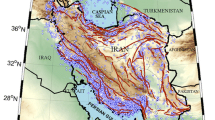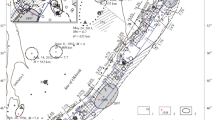Abstract
A regional time and magnitude predictable model has been applied to estimate the recurrence intervals for large earthquakes in the vicinity of 8 October 2005 Kashmir Himalaya earthquake (25°–40°N and 65°–85°E), which includes India, Pakistan, Afghanistan, Hindukush, Pamirs, Mangolia and Tien-Shan. This region has been divided into 17 seismogenic sources on the basis of certain seismotectonics and geomorphological criteria. A complete earthquake catalogue (historical and instrumental) of magnitude Ms ≥ 5.5 during the period 1853–2005 has been used in the analysis. According to this model, the magnitude of preceding earthquake governs the time of occurrence and magnitude of future mainshock in the sequence. The interevent time between successive mainshocks with magnitude equal to or greater than a minimum magnitude threshold were considered and used for long-term earthquake prediction in each of seismogenic sources. The interevent times and magnitudes of mainshocks have been used to determine the following predictive relations: logT t = 0.05 M min + 0.09 M p − 0.01 log M 0 + 01.14; and M f = 0.21 M min − 0.01 M p + 0.03 log M 0 + 7.21 where, T t is the interevent time of successive mainshocks, M min is minimum magnitude threshold considered, M p is magnitude of preceding mainshock, M f is magnitude of following mainshock and M 0 is the seismic moment released per year in each seismogenic source. It was found that the magnitude of following mainshock (M f) does not depend on the interevent time (T t), which indicates the ability to predict the time of occurrence of future mainshock. A negative correlation between magnitude of following mainshock (M f) and preceding mainshock (M p) indicates that the larger earthquake is followed by smaller one and vice versa. The above equations have been used for the seismic hazard assessment in the considered region. Based on the model applicability in the studied region and taking into account the occurrence time and magnitude of last mainshock in each seismogenic source, the time-dependent conditional probabilities (PC) for the occurrence of next shallow large mainshocks (Ms ≥ 6.5), during next 20 years as well as the expected magnitudes have been estimated.







Similar content being viewed by others
References
Ambraseys N, Bilham R (2003) Earthquakes and crustal deformation in northern Baluchistan. Bull Seism Soc Am 93(4):1573–1605
Bapat A, Kulkarni RC, Guha SK (1983) Catalogue of earthquakes in India and neighborhood from historical period up to 1979. I.S.E.T. (Publ.), pp 1–211
Bufe CG, Harsh PW, Buford RO (1977) Steady-state seismic slip—a precise recurrence model. Geophys Res Lett 4:91–94
Draper NR, Smith H (1966) Applied regression analysis. Wiley, New York, p 407
Ekstrom G, Dziewosnki A (1988) Evidence of basis in estimations of earthquake size. Nature 332:319–323
Gansser A (1964) Geology of the Himalayas. Inter-Science, London
Gardner JK, Knopoff L (1974) Is the sequence of earthquakes in Southern California, with aftershocks removed, Poissonian? Bull Seism Soc Am 64(5):1363–1367
Gutenberg B, Richter CF (1954) Seismicity of the earth and associated phenomena. Princeton University Press, New Jersey, p 310 (publ.)
Kanamori H (1977) The energy release in great earthquakes. J Geophys Res 82:2981–2987
Karakaisis GF (1994) Long term earthquake prediction in Iran based on the time and magnitude predictable model. Phys Earth Planet Interiors 83:129–145
Karakaisis GF, Kourouzidis MC, Papazachos BC (1991) Behaviour of seismic activity during a single seismic cycle. In: International conference on earthquake prediction, vol 1. Strasbourg, 15–18 October, 1991, pp 47–54
Koulakov I, Sobolev S (2006) A tomographic image of Indian lithosphere break-off beneath the Pamir-Hindukush region. Geophys J Int 164:425–440
Mogi K (1985) Earthquake prediction. Academic, San Diego, p 355
Molnar P (1979) Earthquake recurrence intervals and plate tectonics. Bull Seism Soc Am 69:115–133
Oldham T (1883) A catalogue of Indian earthquakes from the earliest time to the end of A.D. 1869. Mem Geol Surv India 19(3):53
Papadimitriou EE (1993) Long term earthquake prediction along the western coast of south and Central America based on a time predictable model. Pure Appl Geophys 140:301–316
Papadimitriou EE (1994a) Long term earthquake prediction of large shallow mainshocks along the Tonga-Kermadec-New Zealand seismic zone based on a time and magnitude predictable model. Tectonophysics 235:347–360
Papadimitriou EE (1994b) Long-term earthquake prediction in the North Pacific seismic zone based on the time and magnitude predictable model. Nat Hazards 9:303–321
Papadimitriou EE, Papazachos BC (1994) Time dependent seismicity in the Indonesian region. J Geophys Res 99:15387–15398
Papadimitriou EE, Papazachos CB, Tsapanos TM (2001) Test and application of the time and magnitude predictable model to the intermediate and deep focus earthquakes in the subduction zones of the circum-Pacific belt. Tectonophysics 330:45–68
Papazachos BC (1989) A time predictable model for earthquake generation in Greece. Bull Seism Soc Am 79:77–84
Papazachos BC (1991) Long term earthquake prediction in south Balkan region based on a time dependent seismicity model. Paper presented at 1st General conference of the Balkan Physicists’ Union, Thessaloniki, September 26–28
Papazachos BC (1992) A time and magnitude predictable model for generation of shallow earthquakes in the Aegean area. Pure Appl Geophys 138:287–308
Papazachos BC (1993) Long term prediction of intermediate depth earthquakes in southern Aegean region based on a time and magnitude predictable model. Nat Hazards 7:211–218
Papazachos BC, Papadimitriou EE (1997) Evaluation of the global applicability of the regional time and magnitude-predictable seismicity model. Bull Seism Soc Am 87:799–808
Papazachos BC, Papaioannou Ch A (1993) Long term earthquake prediction in Aegean area based on a time and magnitude predictable model. Pure Appl Geophys 140:593–612
Papazachos BC, Papadimitriou EE, Karakaisis GF, Tsapanos TM (1994) An application of the time- and magnitude-predictable model for the long-term earthquake prediction of strong shallow earthquakes in the Japan area. Bull Seism Soc Am 84:426–437
Papazachos BC, Karakaisis GF, Papadimitriou EE, Papaioannou Ch A (1997a) The regional time and magnitude-predictable model and its application to the Alpine-Himalayan belt. Tectonophysics 271:295–323
Papazachos BC, Papadimitriou EE, Karakaisis GF, Panagiotopoulos DG (1997b) Long-term earthquake prediction in the Circum-Pacific convergent belt. Pure Appl Geophys 149:173–217
Qin C, Papadimitriou EE, Papazachos BC, Karakaisis GF (2001) Time-dependent seismicity in China. J Asian Earth Sci 19:97–128
Sayil N (2005) An application of the time- and magnitude-predictable model to long-term earthquake prediction in eastern Anatolia. J Seism 9:367–379
Shanker D, Papadimitriou EE (2004) Regional time-predictable modeling in Hindukush-Pamir-Himalayas region. Tectonophysics 390:129–140
Shanker D, Singh HN (2007) Application of the time-predictable model in Peninsular India for future seismic hazard assessment. Acta Geophysica 55(3):302–312
Shimazaki K, Nakata T (1980) Time predictable recurrence of large earthquakes. Geophys Res Lett 7:279–282
Singh VP, Shanker D, Singh J (1992) On the validity of time-predictable model for earthquake generation in northeast India. Proc Indian Acad Sci 101(4):361–368
Singh VP, Duda J, Shanker D (2005) A plausible model for the present day seismicity and tectonic activity in the Hindukush complex zone. J Asian Earth Sci 25:147–156
Sykes LR, Quittmeyer RC (1981) Repeat times of great earthquakes along simple plate boundaries. In: Earthquake prediction, an international review, Maurice Ewing Series. Am Geophys Union 4:217–247
Tandon AN, Srivastava HN (1974) Earthquake occurrences in India. Earthquake Engineering, Jai Krishna volume, Sarita Prakashan (publ.), pp 1–48
Weisberg S (1980) Applied linear regression. Wiley, New York, p 283
Wessel P, Smith WHF (1995) New version of the generic mapping tools released. EOS Trans Am Geophys Un 76:329
Yadav RBS (2009) Seismotectonic modeling of NW Himalaya: a perspective on future seismic hazard. Ph. D. thesis, Department of Earthquake Engineering, IIT, Roorkee, India, 198 pp
Yadav RBS, Shanker D (2006) Vertical distribution of seismic activity and variation of b-value in Hindukush-Pamir-Himalaya and vicinity. In: 13th Symposium on earthquake engineering (13SEE), Department of Earthquake Engineering, IIT, Roorkee, India, December 18–20, pp 315–325
Acknowledgments
The authors are thankful to Dr. B. K. Rastogi, Director General, Institute of Seismological Research for his kind permission to publish this work. Authors are highly indebted to Prof. E. E. Papadimitriou and Prof. V. G. Karakostas, Department of Geophysics, Aristotle University of Thessaloniki, Greece for kindly providing their computer codes. First author is thankful to the Department of Science and Technology and Ministry of Earth Science, Government of India for providing financial support. Some figures were made in GMT software (Wessel and Smith 1995). We acknowledge thoughtful comments and suggestions by Editor-In-Chief Dr. Thomas Glade and two anonymous reviewers which enhanced the quality of manuscript significantly.
Author information
Authors and Affiliations
Corresponding author
Rights and permissions
About this article
Cite this article
Yadav, R.B.S., Shanker, D., Chopra, S. et al. An application of regional time and magnitude predictable model for long-term earthquake prediction in the vicinity of October 8, 2005 Kashmir Himalaya earthquake. Nat Hazards 54, 985–1014 (2010). https://doi.org/10.1007/s11069-010-9519-4
Received:
Accepted:
Published:
Issue Date:
DOI: https://doi.org/10.1007/s11069-010-9519-4




